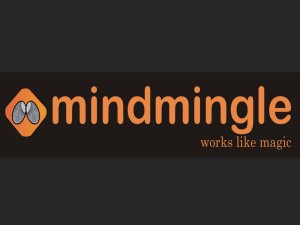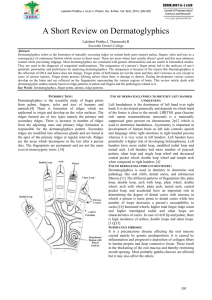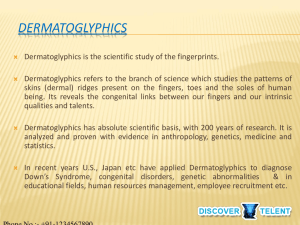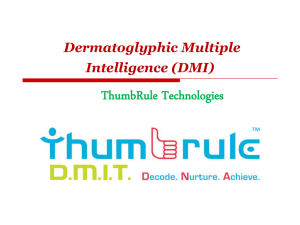Dermatoglyphics - Image Matters Asia
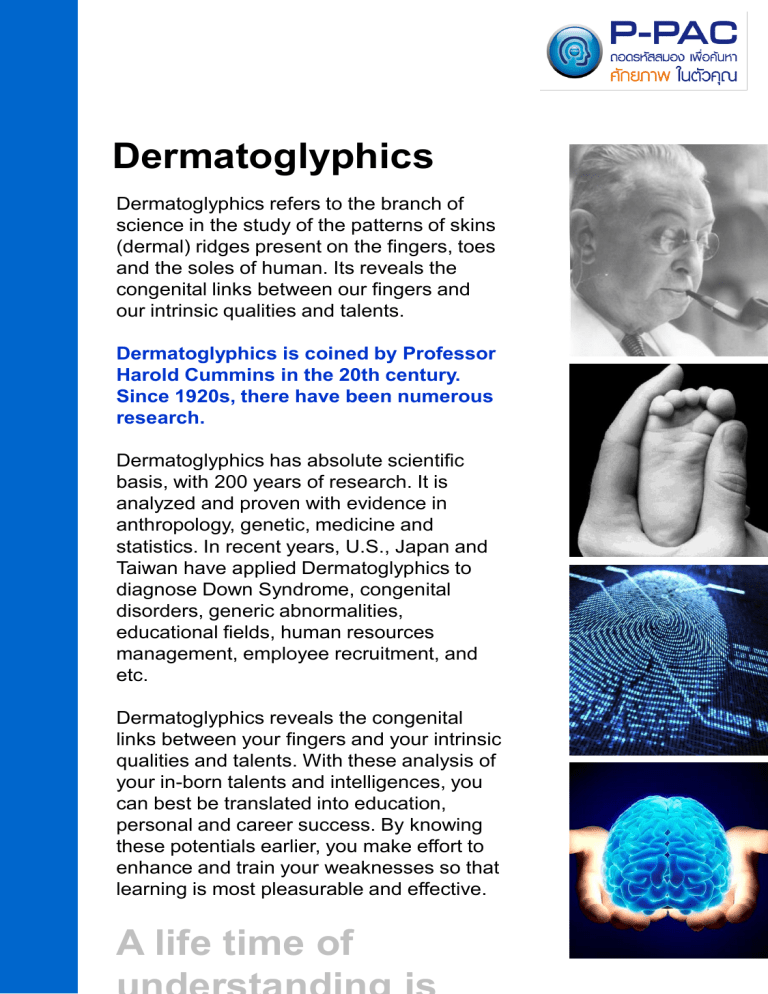
Dermatoglyphics
Dermatoglyphics refers to the branch of science in the study of the patterns of skins
(dermal) ridges present on the fingers, toes and the soles of human. Its reveals the congenital links between our fingers and our intrinsic qualities and talents.
Dermatoglyphics is coined by Professor
Harold Cummins in the 20th century.
Since 1920s, there have been numerous research.
Dermatoglyphics has absolute scientific basis, with 200 years of research. It is analyzed and proven with evidence in anthropology, genetic, medicine and statistics. In recent years, U.S., Japan and
Taiwan have applied Dermatoglyphics to diagnose Down Syndrome, congenital disorders, generic abnormalities, educational fields, human resources management, employee recruitment, and etc.
Dermatoglyphics reveals the congenital links between your fingers and your intrinsic qualities and talents. With these analysis of your in-born talents and intelligences, you can best be translated into education, personal and career success. By knowing these potentials earlier, you make effort to enhance and train your weaknesses so that learning is most pleasurable and effective.
A life time of understanding is
Facts about our fingerprint
Permanence: Fingerprint ridges are formed during the third to fourth month of fetal development. These ridges consist of individual characteristics called ridge endings, bifurcations, dots and many ridge shape variances. The unit relationship of individual characteristics does not naturally change throughout life... until decomposition after death. Permanent scars, disease damage, and temporary changes such as paper cuts appear as jagged edges and sometimes "puckered" ridge detail in opposition to smooth flowing natural formations.
Individuality: In the over 140 years that fingerprints have been routinely compared worldwide, no two areas of friction skin on any two persons (including identical twins) have been found to contain the same individual characteristics in the same unit relationship.
This means that in general, any area of friction skin that you can cover with a dime (and often with just a pencil eraser) on your fingers, palms, or soles of your feet will contain sufficient individual characteristics in a unique unit relationship to enable identification.
Recent studies comparing the fingerprints of cloned monkeys showed that they, just like identical twin humans, have completely different fingerprints. When doctors state that twins have the same fingerprints, they are referring to the class characteristics of the general ridge flow, called the fingerprint pattern.
1
Two different individuals having
Galton, Francis (1892). "Finger Prints". London: MacMillan and Co.
the same fingerprints is about
1 in 64 billion
[1]
Who will benefit?
The developing brain generates between 50 to 100 thousand new cells per second from the fifth through twentieth weeks of gestation 1 .
These brain cells migrate to different locations in the brain and begin to differentiate. However, if we understand where our potentials lie, we can stimulate these neurons to help us succeed in different fields.
Toddlers (age 1-4)
From birth through about age three there are vast numbers of connections and collections being recorded in the brain.
Benefits: Knowing a toddler ’s potentials at the early age help parents make decisions on parenting styles and educational methods.
Children (age 4-12)
From age three through twelve the brain begins to prune the excessive synapses in an attempt to get organized and eliminate what is not necessary.
Benefits: At this age, Children are curious to learn and they can absorb more than they will when they grow older. Discovering their learning styles and areas of intelligences at this age gives a clue on what courses and activities they should spend more time on.
Teenagers & Young Adults (age 12-25)
The teenage years consist of more aggressive pruning as the brain begins to specialize and build an identity.
Benefits: Discovering learning styles at this age can better enhance one ’s learning experience. It also serves as a guideline on what type of courses one should take.
Adult (age 25+)
Adulthood ushers in a bit of a pruning plateau, where some connections are diminished and others are enhanced.
Benefits: Understanding one ’s areas of intelligences help an adult make decisions on careers. Understanding more about self can help adults communicate better and thus build better relationships.
Employers can also apply Dermatoglyphics analysis to find out the strength and weakness of their employees for position placement.
1 http://neurons.wordpress.com
Company (Human Resource Development)
Human resource development is a framework for helping employees develop their abilities and organizational skills in order to achieve company's goals. The ultimate goal of HRD is putting the right man in a right job and grooming them to operate the company.
Benefits : Understanding employee ’s skills is important to companies in many areas such as talent managing, recruiting, training, and career development.
Content of Dermatoglyphics
(interpersonal skills)
• right-wrong judgment, self-consciousness, self-discipline and social function (introspection skills)
• creative idea, imagination processing, image thinking and selfexpectation
• personal expressive way, logic procession, image thinking and self-expectation
• sequence thinking and self-evaluation
2. Personal Characteristic
• personality characteristics
• behavior tendency
• communication skills
3. Work Characteristic
• primary and secondary
4. Innate Intelligent Distribution
• introspection ability / creative ability / art appreciation ability / image perception ability / linguistic ability / somatosensory ability / operating ability / reasoning ability / observation ability / mental image ability
5. Formation of Acquired Intelligence
• Individual intelligences
• how to enhance your ability
• key elements of development
6. Learning Styles
• individual learning style
• factors that affect learning ability
• factors that influence learning ability
7. Learning Types
• individual learning type (vision / auditory / kinestatic / encoder / motivate)
8. Sensitivity of Learning
• intuition and sensitivity of recognition sensory organs (vision, hearing, smell, taste, touch and motor
9. Brain Characteristic
• potential learning of brain
• sensation and reasoning
• degree of openness
Research References
“Hand of Clinical Dermatoglyphs” Musallam S. Elbualy & Joan D. Schinderler, University of Miami Press 1971
“Dermatoglyphics in Medical Disorders”, Blanka Schauman & Milton Alter, New York Springer – Verlag 1976
“Trends in Dermatoglyphics Research”, Norris M. Durham, Chris C. Plato, edited, Kluwer Acadic Publishers 1990
“The State of Dermatoglyphics: The science of Finger and Palm Prints", N. M. Durham, K. M. Fox, C. C. Plato, The Edwin
Mellen Press, 2000
“Study of Dermatoglyphics in Tall Statures”, Journal of Guangzhou Physical Education Institue, Cao Yongping and Lai
Rongxing; no:1 1996
“A Dermatoglyphic Study of the Chinese Population III. Dermatoglyphics Cluster of Fifty-two Nationalities in China”, Acta
Genetica Sinica, Zhang Hai-guo, Ding Ming. Jiao Yun-ping; et al. no:5 1998
“Principal component analysis on the Dermatoglphics feature of 24 populations in China”, Journal of Shanxi Medical
University, Lu Shunhuan: Zhang Bingwen: no:s1 1998
“Principal Component Analysis on Dermatoglyphics of Populations in China”, Acta Anthropologica Sinica, Zheng Lian-bin:
Lu Shun-hua; Zheng Qi; Li Shu-yuan; no: 3 2002.
“Dermatoglyphics of Xinjiang Tatar nationality in China” , Chinese Journal of Anatomy, Yuan Jiang-Bin; Xu Shuang-Jin;
Zhen Hai-Guo; et. al., no: 2 2003.
“A Dermatoglyphics Study of the Qinghai Salar Nationality of China” , Acta Anatomica Sinica, Wang Ping; Wang Han
;Zhang Hai guo; no: 2 2003.
“The Russ Nationality Dermatoglyphics Investigation in Xinjianga” , Acta Anatomica Sinaca, U Shuangjin; Zhang Haiguo;
Yuan Jiangbin; no: 6 2004.
“Hand Dermatoglyphics of Male Teenaged Miao Nationality Students” , Acta Academiae Medicinae Guangxi, Li Houwen,
Mao Tingzhi; no: 2 1997.
“The Dermatoglyphics Study of Hui and Han Nationalities in Ningxia, China---- I Fingerprint”, Acta Anatomica Sinica, Dang
Jie; Huo Zheng-hao; Peng Liang; et. Al. no: 4 2007.
“Investigation and analysis on (f)t triradius and other dermal ridge of the sole”, Chinese Journal of Birth Health & Heredity,
Luo Tongxiu; Xu Mingzing; Li Shiwang. no: 2 2001.
“Analysis of Curriculum Construction of the Elective of Human Dermatoglyphics” Researches in Medical Education, Zhang
Hai-guo; Yu Song; no; 7 2007.
“Palmar Dermatoglyphics of Dyslexia; A Test of Geschwind hypothesis ” , PhD. dissertation., Indiana University.” Soreson
Jamison C, 1987
“Palmar Dermatoglyphics of dyslexia” Am J Phs Anthropol Sorenson Jamison C 76:505-513 1988
“Dermatoglyphics study in autistic children and controls.” J.Am Acad. Child Adolesc Psychiatry Wolman SR, Campbel I M,
Marchi ML, Deutsch SI & Gershon TD 29(6) : 878-884 1990
“Ridge hyperplasia and ridge dissociation ; minor anomalies in autistic children.” Clin Genet Arrieta MI. Martinez B, Criado
B, Lobato N & Lo—stao CM 44: 107-108 1993
Research References
(continued)
Journal of
Biomathematics, Ma Junying; Liu Laifu; Xu Xinzhai; Chen Lewen no: 3 1994.
“A case-control study of fluctuating Dermatoglyphics asymmetry as a risk marker for developmental delay.” Am. J of Med
Genet Naugler CT&Ludman MD 99(1) : 11-14 1996
“A case-control study of fluctuating Dermatoglyphics symmetry as a risk marker for developmental delay.” Am. J of Med
Genet Naugler CT&Ludman MD 66(1) : 11-14 1996
“A Dermatoglyphics study on the nurse students of different degrees”, Journal of Shanxi Medical University, Yang Xiang;
Zhang Limei; Jiang Yuzhu, no: s1 1998
“Dermatoglyphics Survey of 456 Hebei North University Students” Journal of Zhangjiakou Medical Collage, Wei Huiping; Liu
Jiyun; Pan Yongna no: 5 2004
“Dermatoglyphics study of children with specific developmental disorders of scholastic skills”, Journal of Psychiatry, Feng
Zhi-ying; Zhang Yong-hui; Liu Jian-xun; et al. no: 1 2007
“The Configuration of Epidermal Ridges in a human A cephalic Monster”, Anat Rec. 26; 1, H. Cummins 1923
“Dermatoglyphics Stigmata in Mongolian Idiocy”, Anat. Rec 64: 11. H, Cummins, 1936
“Fluctuating Dermatoglyphics asymmetry and the genetics of liability to schizophrenia.” Psychiatry Research. Markow T.A. and Wandler K., 17 : 348-370, 1967
“Dermatoglyphic studies in carcinoma of the cervix” Indian J. of Pathology and Microbiology. Subramanyam Reddy S., Ahuja
J.R., Reddi O.S.,9 : 35-41, 1977.
“Dermatoglyphics, study in breast carcinoma.” Indian Journal of Pathology and Microbiology Singh D., Prabhakar B.R.,
Bhalla S.S., 22:27-32, 1979
“Quantitative Dermatoglyphics traits in patients with breast cancer.” Preliminary report. Acta Medica lugoslavica Rudan, P. et. al. 34: 73-79 1980
“The use of Dermatoglyphics in non-chromosomal aberrations.” Dermatoglyphics Floris G 9(2) :56-63 1981
“Dermatoglyphics studies in carcinoma of cervix.” Dermatoglyphics Gupta, M.K., Laha, N.N., Mor D.K. 9:2-7. 1981
“Dermatoglyphics studies in carcinoma of cervix.” Dermatoglyphics, 9: Gupta M.K., Laha N.N., Mor D.K., : 2-7, 1981
“Dermatoglyphics in Sacthre-Chotzen syndrome: A Family study.” Acta Paediat Hung Borbol Ia, L., Menendez, I. 24:269,
1983
Fingerprint patterns in Alzheimer’ s Disease.” Archives of neurology Weinreb, H. 42(Jan) 1985
“Dermatoglyphic patterns in Alzheimer's Disease.” J of Neurogenetics Weinerb, H. 3:233-246 1986
“Some Dermatoglyphics traits in breast carcinoma.” International J of Andrology, Floris G., Sanna E., Paden R., 9 : 87-88,
1986
“Dermatoglyphics in breast carcinoma.” Preliminary note. Floris, G., Paderi, R., Sanna, E. CA 6:13-14. 1986
What is
P-PAC
?
Special
Promotion
only for
STCC members
10%
off
From now to
December 31, 2010
3 Easy Steps:
1 Call 0-2648-2999 for scanning appointment and let us know that you are
STCC members
2 Visit our centre for scanning process (15-30 minutes), make an appointment for a personal consultation and make your payment.
3 Visit our centre for a personal consultation together with a full analysis report
